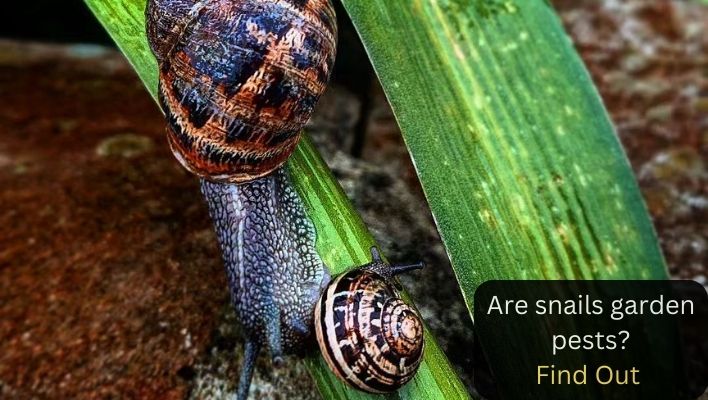Are snails garden pests? If you’ve ever seen slimy trails snaking through your garden beds or noticed holes in the leaves of your favorite plants, you might have wondered if these slow-moving creatures are to blame.
As an avid gardener, you’ve probably encountered a pesky snail or two munching on your beloved plants. You may have even wondered, Are these snails pests? Well, the answer is yes! Snails are notorious garden pests that can cause significant damage to your plants.
These slimy creatures love to feast on leaves, stems, and even the fruit of your plants, leaving them vulnerable to disease and death. But don’t worry, there are ways to prevent and control snail infestations in your garden.
In this article, we’ll explore everything you need to know about snails as garden pests, including their behavior, the damage they can cause, and how to keep them at bay. So let’s get started and say goodbye to those pesky snails once and for all!
Are Snails Garden Pests?
Garden pests are creatures that cause damage to plants, whether by feeding on them, burrowing into them, or spreading diseases. They can be insects, rodents, birds, or even larger animals like deer. In short, any organism that poses a threat to the health and vitality of your garden can be considered a garden pest.
When it comes to snails, they are often regarded as potential garden pests due to their feeding habits. Snails are notorious for their love of munching on tender young leaves, and they can quickly decimate a row of seedlings if left unchecked.
They use their rasping mouthparts to scrape away at the surface of leaves, leaving behind ragged edges and unsightly holes. In some cases, they can also feed on the stems or fruit of plants, causing further damage.
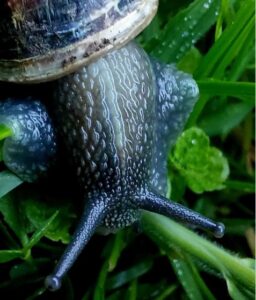
But that’s not all – snails can also damage plants by leaving behind a trail of slime. This slimy substance not only looks unsightly, but it can also create a moist environment that promotes the growth of mold and other fungi. Additionally, if snails are carrying any diseases or parasites, they can potentially transmit these to your plants via their slime trail.
However, it’s important to note that not all snails are pests, and some species can even be beneficial to gardens. Some snails are decomposers that help to break down organic matter in the soil, while others are preyed upon by birds and other predators, which can help to balance ecosystems.
All in all, snails can definitely be considered garden pests, particularly if you’re trying to cultivate a vegetable or herb garden. However, it’s worth noting that not all snails are equally destructive, and some species may pose less of a threat than others. In the next section, we’ll take a closer look at the specific ways that snails can cause damage to your garden.
Sings of snail infestation
Here are some signs that you may have a snail infestation in your garden:
- Chewed leaves: Snails are known for their voracious appetite and can quickly munch their way through your garden plants. If you notice holes or ragged edges on your plant leaves, it could be a sign of snail damage.
- Slimy trails: Snails leave behind a distinctive slimy trail as they move around your garden. If you notice a shiny, silver trail on your plants or the ground, it could be an indication of snail activity.
- Damage to seedlings: Snails are particularly fond of young, tender plants and seedlings. If you have recently planted seeds or young plants and notice that they are being eaten or damaged, it could be a sign of snail activity.
- Visible snails: Of course, the most obvious sign of a snail infestation is simply seeing the snails themselves. If you notice snails crawling around your garden during the day, it could be an indication that there are too many snails in the area.
- Shiny or slimy surfaces: Snails leave behind a slime trail wherever they go, which can make surfaces appear shiny or slimy. If you notice this on your plant leaves, pots, or garden furniture, it could be a sign of snail activity.
- Brown spots on leaves: Snails have a rasping mouthpart called a radula, which they use to scrape away at plant surfaces. This can leave behind brown spots on leaves or stems, which may indicate snail damage.
- Empty snail shells: Snails have a hard outer shell that protects their soft bodies. If you notice empty snail shells lying around your garden, it could be a sign that snails are present in the area. Snails will often retreat into their shells during the day to avoid heat and predators, so if you see empty shells, it could be an indication of snail activity.
If you notice any of these signs, it’s important to take action to control the snail population in your garden. By using prevention techniques and various control methods, you can minimize the damage that snails cause to your plants and keep your garden healthy and beautiful.
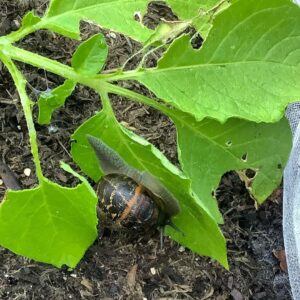
Are there any Benefits of Snails in the Garden?
While snails are often seen as pests that can wreak havoc on your garden, they do have some benefits that are worth considering. Here are a few of the ways that snails can be beneficial to your garden:
- They help break down organic matter. Snails are decomposers, which means that they can help break down dead plant material and other organic matter in your garden. This can help to enrich your soil and create a healthier growing environment for your plants.
- They can contribute to soil health. As snails move through your garden, they leave behind droppings that contain nitrogen and other nutrients. Over time, these droppings can help to fertilize your soil and promote healthy plant growth.
- They can be food for other creatures. Snails are an important food source for a variety of animals, including birds, snakes, and other predators. By providing food for these creatures, snails can help to support a healthy ecosystem in your garden.
Here’s a possible explanation:
While snails are often regarded as garden pests, they do have some positive attributes that shouldn’t be overlooked. For starters, they are an important part of the ecosystem and can contribute to soil health.
When snails feed on dead plant material, they help to break it down into smaller pieces that can be more easily decomposed by other organisms like bacteria and fungi. This process releases nutrients back into the soil, which can benefit your plants in the long run.
In addition, snails can also serve as a food source for other creatures in the garden, such as birds, lizards, and some species of beetles. By providing a steady source of food for these predators, snails can help to maintain a healthy balance in the garden ecosystem. In fact, some gardeners even intentionally cultivate snails as a food source for their pets, such as chickens or reptiles.
Finally, it’s worth noting that not all snails are equally destructive in the garden. Some species, such as the garden snail (Helix aspersa), are considered to be more of a nuisance than a true threat to plant health. In fact, some gardeners even find these snails to help control weeds, as they will often feed on the leaves of unwanted plants that have sprouted up in the garden.
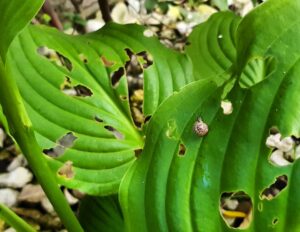
It’s worth noting that these benefits are generally outweighed by the potential damage that snails can cause to your plants.
While snails can certainly be a challenge for gardeners to deal with, it’s important to remember that they do have some positive aspects as well.
By taking steps to control their populations and minimize their impact on your plants, you can strike a balance that allows them to coexist with other garden inhabitants.
How to get rid of snails in the garden
Handpicking:
One of the simplest and most effective ways to get rid of snails is to pick them off your plants by hand. Wear gloves to protect your hands, and check your plants regularly for snails. Then, remove any snails you find and dispose of them far away from your garden.
Traps:
You can also use traps to capture snails in your garden. One common type of trap is a beer trap – simply fill a shallow container with beer and place it in your garden. Snails will be attracted to the beer and will fall in and drown.
Natural predators:
You can encourage natural predators of snails in your garden, such as birds, toads, and beetles. Provide habitat and nesting areas for these creatures to help keep snail populations under control.
Chemical control:
If all else fails, you can use chemical pesticides to control snails in your garden. However, it’s important to use these products carefully and according to the instructions, as they can be harmful to other creatures and can pollute the environment.
Snail bait:
One common method for getting rid of snails in the garden is to use snail bait. Snail baits contain a chemical called metaldehyde that is toxic to snails and slugs. When snails consume the bait, they become paralyzed and eventually die.
To use snail bait effectively, it’s important to follow the instructions on the package carefully. Most snail baits come in pellet form and should be scattered around the garden in areas where snails are known to congregate.
Salt:
Sprinkling salt around your plants can kill snails by dehydrating them. However, this method should be used with caution, as too much salt can also harm your plants and soil.
Diatomaceous earth:
Diatomaceous earth is a powder made from the fossilized remains of diatoms. It works by dehydrating snails and other pests that come into contact with it. It is important to know that DE is more effective as a deterrent and not as a way to get rid of them. Sprinkle a layer of diatomaceous earth around your plants to create a barrier that snails will avoid.
Plant selection:
Some plants are more resistant to snail damage than others. By choosing plants that snails are less likely to eat, you can reduce the chances of a snail infestation in your garden. For example, plants with tough or fuzzy leaves, such as rosemary, lavender, and thyme, are often less appealing to snails.
Cultural practices:
There are several cultural practices that can help to discourage snails in your garden. For example, watering your plants in the morning instead of the evening can help to reduce moisture levels, which can make your garden less hospitable to snails. You can also keep your garden tidy and free of debris, which can provide hiding places for snails.
Companion planting:
Companion planting involves growing certain plants together to repel pests or attract beneficial insects. Some plants are thought to repel snails, such as garlic, chives, and fennel. By interplanting these with your other garden plants, you may be able to discourage snails from taking up residence.
Predatory nematodes:
Predatory nematodes are microscopic worms that feed on snails and other pests. You can purchase nematodes from a garden center or online, and then release them into your garden soil. They will seek out snails and other pests and help to control their populations.
Physical barriers:
Finally, you can use physical barriers to keep snails out of your garden altogether. For example, you can create a raised bed and line the sides with a strip of copper, which will prevent snails from crawling in. Alternatively, you can install a mesh fence around your garden to keep snails and other pests out.
It’s worth noting that some of these methods may work better than others, depending on the severity of the snail infestation and the specific conditions in your garden. You may need to experiment with several different approaches to find the one that works best for you.
Just remember to be patient and persistent – it may take some time and effort to fully control a snail infestation, but with the right approach, it’s definitely possible.
How to prevent snails in the garden
Keep your garden tidy:
Snails like to hide in dark, moist areas, so it’s important to keep your garden tidy and free of debris. This includes removing fallen leaves, branches, and other plant debris that can provide shelter for snails.
Remove potential food sources:
Snails are attracted to certain types of plants, so if you have a problem with snails in your garden, consider removing or relocating these plants. You can also try planting snail-resistant species instead.
Use barriers:
Barriers can be an effective way to prevent snails from reaching your plants. Copper tape or copper wire can be placed around the base of plants or pots to repel snails. Eggshells, sandpaper, or rough burlap can also be placed around plants to create a rough surface that snails will avoid crawling over.
Create a dry environment:
Snails thrive in moist environments, so by creating a dry environment, you can make your garden less attractive to them. Avoid overwatering your plants and use a drip irrigation system to keep water off the leaves and flowers.
Introduce predators:
Certain animals such as birds, frogs, and toads are natural predators of snails. By creating a garden that attracts these animals, you can help to keep snail populations in check.
Use organic pest control products:
There are several organic pest control products that can help to prevent snails in your garden. For example, iron phosphate baits can be used to attract snails and then kill them. These baits are safe for pets and wildlife and won’t harm the environment.
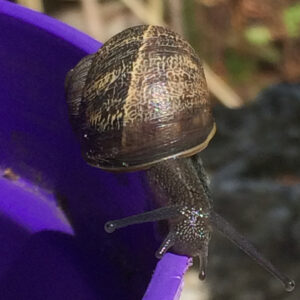
Use companion planting:
Companion planting involves growing certain plants together to repel pests or attract beneficial insects. Some plants are thought to repel snails, such as garlic, chives, and fennel. By interplanting these with your other garden plants, you may be able to discourage snails from taking up residence.
Use mulch carefully:
While mulch can help to retain moisture in the soil and reduce weed growth, it can also provide a hiding place for snails. If you use mulch in your garden, be sure to use it sparingly and avoid piling it up around the base of plants.
Are snails garden pests FAQs
What plants do snails prefer to eat?
Snails are known for their voracious appetite and will eat a wide range of plants. However, they tend to prefer plants with soft, succulent leaves such as hostas, lettuce, and strawberries. They also like to feed on flowers and fruit, especially ripening fruit. In general, snails will eat any plant that is within their reach and is soft enough for them to consume.
How can I tell the difference between snail damage and damage caused by other pests?
It can be difficult to differentiate between damage caused by snails and other garden pests, as many pests will also eat plant leaves and stems. However, there are a few clues that can help you identify snail damage.
Snails tend to eat irregular-shaped holes in leaves, leaving behind ragged edges. They may also leave a distinctive slimy trail on the leaves or on the ground.
Other pests, such as caterpillars, tend to eat more uniform holes in the leaves and may leave behind frass (caterpillar droppings). If you’re unsure of the cause of the damage, you can try inspecting your plants at night when snails are most active, or set up traps to catch the pests in action.
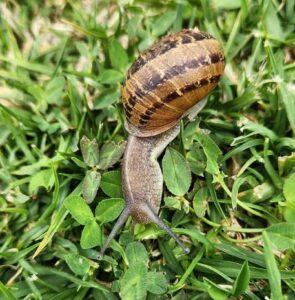
How do I safely dispose of snails after I’ve removed them from my garden?
If you’re manually removing snails from your garden, it’s important to dispose of them in a way that won’t harm the environment. One option is to relocate the snails to a nearby wooded area or park.
Alternatively, you can collect the snails in a container and freeze them, which will kill them without the use of chemicals. Some people also choose to compost snails, but it’s important to make sure that your compost heap reaches a high enough temperature to break down the snails completely.
Are there any humane ways to remove snails from the garden?
Yes, there are several humane ways to remove snails from the garden. One option is to use copper barriers, which are strips of copper that are placed around the perimeter of the garden. Snails are repelled by copper and will avoid crossing the barrier.
Another option is to use snail traps, which are containers filled with beer or yeast that attract and drown the snails. You can also try using hand picking, which involves manually removing snails from your plants and relocating them. It’s important to note that chemical pesticides should be used as a last resort, as they can harm other beneficial insects and wildlife in your garden.
Conclusion
Snails can be both beneficial and detrimental to your garden. While they can help to break down organic matter and improve soil health, they can also damage your plants and cause significant harm to your garden.
Signs of snail infestation include irregular-shaped holes in leaves and the presence of a slimy trail. To get rid of snails, you can try a variety of methods, including handpicking, copper barriers, and snail traps.
To prevent snails from infesting your garden in the first place, you can take steps such as removing debris and creating a dry, well-drained environment.
It’s important to note that while chemical pesticides may be effective at controlling snail populations, they should be used as a last resort and with caution, as they can harm other beneficial insects and wildlife in your garden. By taking proactive measures to prevent and control snail infestations, you can help to ensure a healthy and thriving garden.
With proper management, gardeners can strike a balance between keeping snails at bay and harnessing their benefits for a healthy garden ecosystem.
